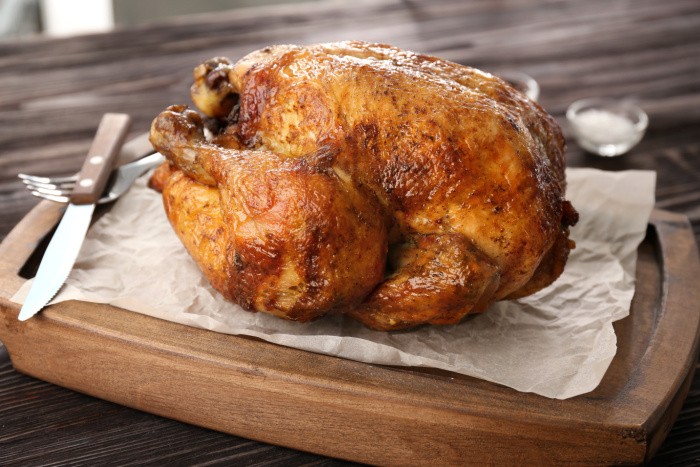
Can you believe November is here already? It seems like I just finished making homemade donuts for Halloween. Today, I want to share how to cook a turkey because the holidays are right around the corner. I decided to update and repost this information because I want everyone to know the best way to cook a turkey for a Thanksgiving Feast or Christmas Dinner!
Here’s the deal: I realize some people go out to restaurants for holiday meals. It sounds terrific, right? No prep, no cleanup, no mess, but also no leftovers! Or as my reader Deborah states, and no “encore meals,” I love that term.
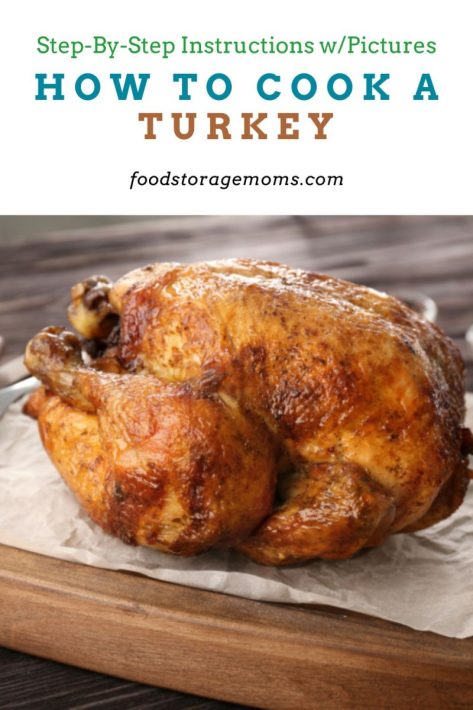
My goal is, and always has been, to teach others to cook from scratch. Today is no different. I have fond memories of my mom baking a turkey at this time every year when the family could get together. We had tablecloths, china, and her goblets, which she loved to use just for special meals.
We all pitched in, brought our specialty dishes, set the tables and chairs, and squished in together to enjoy a turkey feast. It’s all about memories in the kitchen and dining room together. Then we all cleaned up —so many dishes —but it didn’t matter because we worked as a team. We laughed and shared fun stories of years past and a few family secrets.
This year, it was truly sticker shock when purchasing turkeys for this post. Luckily, I have grandchildren nearby who will use the leftovers for meals over the next few days. I’ll show you the difference between cooking a turkey in a roaster pan in the oven and in an electric roaster.
Yes, I purchased two turkeys. Luckily, I have family to help with kitchen chores and eating, although not all of them live nearby. Contrary to some families’ Thanksgiving meal antics, we have a wonderful time together!
How to Prepare a Raw Turkey For Roasting
Step One – Thaw Your Turkey, if Needed
We placed the two turkeys on a cookie sheet in case any liquid from the turkeys in the refrigerator leaked as they thawed. It took almost 5 days to thaw them out, wow!
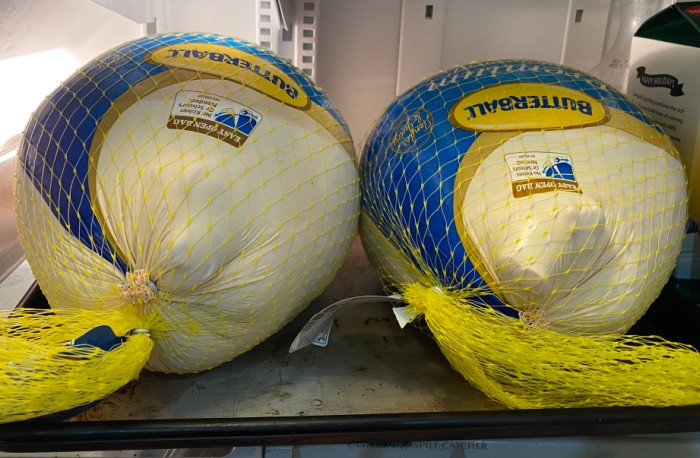
Step Two – Remove all Wrapping From the Raw Turkey
Here is one of the turkeys, thank goodness my daughter has a deep sink so we can cut the wrapping off of the raw turkeys.

Step Three – Wash Raw Turkey – Clean Area After Washing
I always wash my raw chickens and turkeys, then pat them dry with paper towels. According to the USDA, we should not wash the turkey before we bake it. Here is the reasoning: I quote the USDA, “According to the USDA Food Safety and Inspection Service, washing raw poultry, beef, pork, lamb, or veal before cooking is not recommended. Bacteria in raw meat and poultry juices can be spread to other foods, utensils, and surfaces.”
Well, I am cautious about using bleach to wash down all the areas around the kitchen sink after I’ve washed the turkeys. I pay particular attention to the immediate area where I washed my turkey. But, this is totally up to you. It’s better to be safe than sorry, either way you choose.
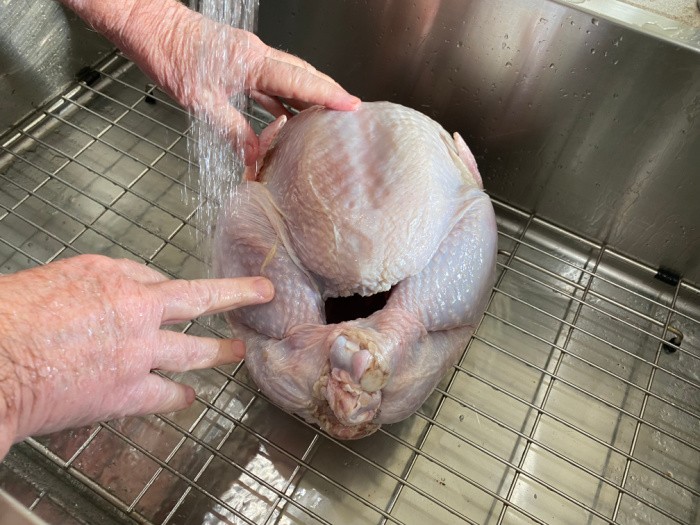
Step Four – Remove the Bag of Gizzards
The picture shows the turkey’s back, where you will find a bag full of gizzards (also known as giblets) and the heart. Remove the bag and decide if you want to cook the contents. My mother always saved the gizzard(s), and Mark always saved the heart to cook it and eat it later. This year, we discarded all of it. No one in my family will eat them, not even in dressing or stuffing.
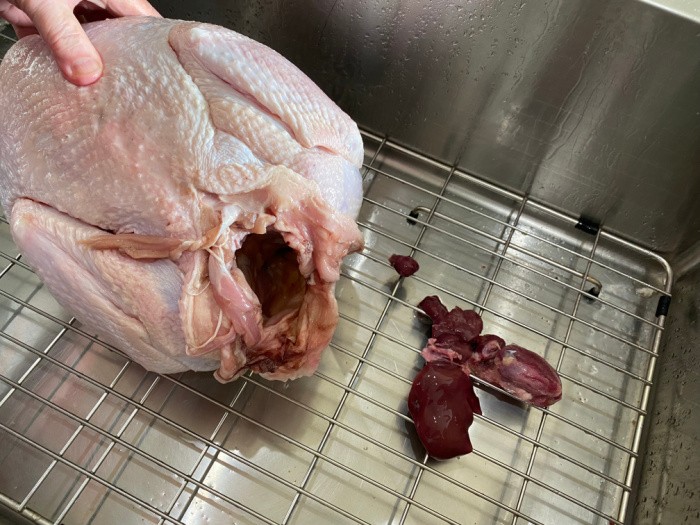
Step Five – Remove Neck and Discard.
This is the front of the turkey, where you’ll find the neck deep in the cavity. Remove the neck and discard it, unless you want to boil it for soup later. We never keep it because it has so little meat. It’s totally a personal preference. If you’ve ever watched the movie with Chevy Chase, “Christmas Vacation,” you’ll remember someone in the movie ate the neck. I can’t remember who it was. LOL!
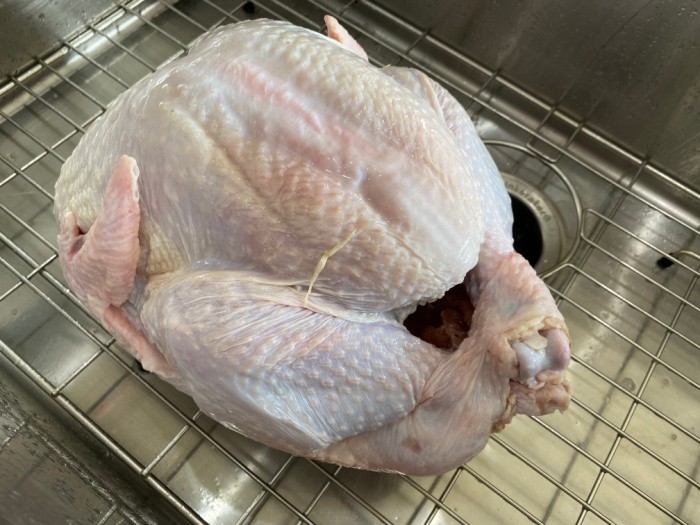
Step Six – The Neck Should Look Like the Picture Below
You can see the turkey’s neck in the picture below.

How to Cook a Turkey in a Roaster Pan
Step One – Place Turkey in Roaster Pan, Uncovered – Set Oven Temp to 325°F (165 °C).
This is the first turkey that’s ready to put in the oven. We’ll put it on the oven’s roasting rack after placing it in a roasting pan, uncovered, as shown. If the turkey starts to brown too quickly, I’ll place a foil tent over the whole turkey. We set the oven temperature at 325°F. 165°C.
Remove all racks from the oven except the bottom rack you will be using. Cook the turkey breast-side up in the roaster pan at the set temperature. See additional instructions below for cooking times based on weight.

Final Product – Turkey Baked in a Roaster Pan Cooked in a Conventional Oven
This one was cooked in the conventional oven, and you can see it must have caught the top of the beautiful turkey as I pulled it out. It still tastes fabulous! Note the lovely brown color of the roasted turkey when cooked in the conventional oven.
Once the turkey has cooked, allow it to cool to room temperature, and then it will be ready for carving!
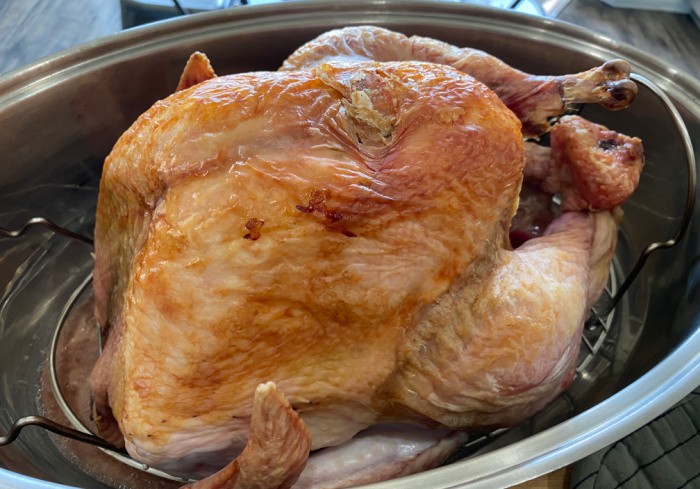
How to Cook a Turkey in an Electric Roaster
Step One – Place Turkey in Electric Roaster – Cover With Roaster Lid – Set Temperature to 325°F (165 °C).
This second turkey is going in the electric roaster, which will be covered with the roaster lid. We set the electric roaster temperature at 325°F. 165°C. Cook the turkey breast-side up in the electric roaster at the set temperature. See additional instructions below for cooking times based on weight.
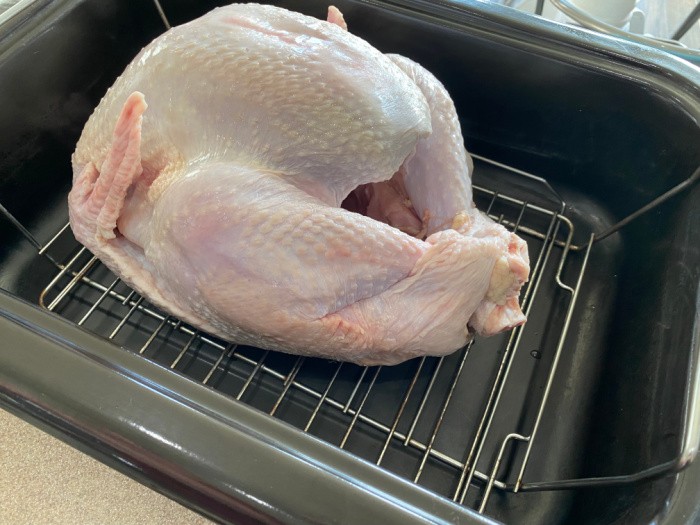
Final Product – Turkey Baked in an Electric Roaster Pan
This is the turkey we baked in the electric roaster pan. The flavor is excellent, but I love having a “browned” turkey. I could have put it in the conventional oven to brown it, but it’s fine as is. It sure cooked faster in my electric roaster. Some people allow the turkey to cool to room temperature before carving. Mark sometimes jumps the gun and starts carving ours right out of the oven or the roaster! As noted in the section below on turkey carving, a hot turkey may cause juices to escape during carving, so if you like moist meat, let the turkey cool a bit first.
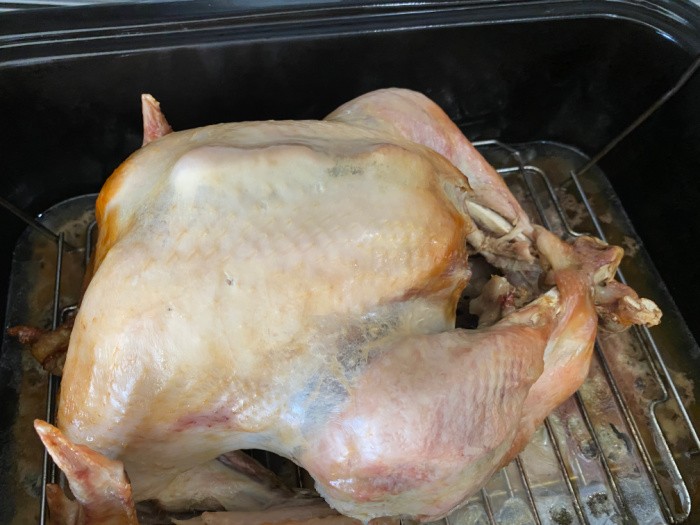
How do I thaw a frozen turkey?
I know we don’t always agree with, or possibly trust, information from a government agency. Things have become so political these days. I will say that I have found almost everything relating to food preparation to be pretty reliable when issued by the USDA.
That being said, here is a quote from the USDA regarding the proper process when thawing a frozen turkey: “The USDA recommends thawing your turkey in the refrigerator.
This is the safest method because the turkey will thaw at a consistent, safe temperature. This method takes some time, so allow 1 day per 4-5 pounds. If your turkey weighs 16 pounds, it will take about 4 days to thaw. “How to Safely Thaw a Turkey.”
On its website, the USDA offers other options if you don’t want to thaw your turkey in the fridge for the suggested days. The first approach they mention is the cold-water method.
Cold Water Method
The instructions are to leave the turkey in its original wrapping, then submerge it in either your sink or a large container of cold water. They suggest using cold water, since you want the turkey to stay “cold” and not reach a temperature that is unsafe when using hot water.
You need to change the water every 30 minutes by emptying it and replacing it with fresh, cold water. They indicate that you should plan for about 30 minutes of defrosting time per pound, so a 10-pound turkey would take approximately 5 hours to thaw. You would then need to cook the turkey immediately.
The problem I see with this method is having to hang around all day (or night) changing out the water as indicated. Yes, it thaws faster, but it sure becomes a more “hands-on” method.
From the USDA
The USDA says to be sure and check your microwave oven owner’s manual on the proper process, but they suggest removing the wrapping and placing the turkey on a tray to catch the drippings as the bird cooks. They indicate it should take about 6 minutes per pound.
Note that most microwaves don’t have a revolving tray large enough to handle the average Thanksgiving turkey, so you’ll need to rotate the turkey several times during cooking and flip it at least once.
This process is designed to thaw the bird, not cook it, so be aware of any spots where the bird is actually being heated past the thawing phase and either cover that area or stop the process and start cooking the turkey in your oven at that point.
I did want to mention that the USDA did say you CAN cook a frozen turkey; you need to plan on cooking time being at least 50% longer than for a defrosted turkey. As for me, I use the refrigerator approach and have done so for years.
There are some old wives’ tales about how to thaw a turkey, and the USDA says to be sure NOT to use one of these methods:
- thawing the bird on your kitchen counter, in the garage, or on the back porch
- using a brown paper bag or plastic garbage bag
- using your dishwasher, either with or without the water
- any other method that isn’t listed above
Can I buy a fresh turkey?
Right now, turkeys are becoming a commodity in short supply. Depending on where you live, finding one could be a challenge. I haven’t noticed any particular benefit to a fresh turkey in terms of flavor, tenderness, moist texture, or other attributes you may consider necessary. If you thaw it out and cook it as recommended, you should be fine, and you’ll like the results.
How long do I cook a turkey?
Most cooks seem to have their favorite approach to Thanksgiving turkey preparation and cooking time. I’ve tried the “cook all night” method at a slightly lower temp, and the “morning of” method, where you cook at higher temps for a shorter time.
The key is to try to get the turkey fully cooked and ready to serve when it reaches and maintains a temperature of 165 degrees. The best way to test the temperature of the turkey is to insert a cooking thermometer into the thickest part of the thigh or breast of the bird. This will give you the most accurate reading.
I’ve listed below some cooking times based on weight and whether you are also cooking your stuffing “in the bird,” which the USDA frowns upon, by the way:
All cooking times are based on a minimum temperature of (325°F) = (162°C).
UNSTUFFED STUFFED
4 to 8 lbs = 1.5 to 3.25 hours 6 to 8 lbs. = 2.5 to 3.5 hours
8 to 12 lbs. = 2.75 to 3 hours 8 to 12 lbs. = 3 to 3.5 hours
12 to 14 lbs. = 3 to 3.75 hours 12 to 14 lbs. = 3.5 to 4 hours
14 to 18 lbs. = 3.75 to 4.25 hours 14 to 18 lbs. = 4 to 4.25 hours
18 to 20 lbs. = 4.25 to 4.5 hours 18 to 20 lbs. = 4.25 to 4.75 hours
20 to 24 lbs. = 4.5 to 5 hours 20 to 24 lbs. = 4.75 to 5.25 hours
Remember that not all ovens cook at the same temperature and that altitude MAY make a difference, too.
How do I brine a turkey?
I’ll admit I seldom brine my turkey before cooking it. I haven’t found that the flavor and moisture of the meat are enhanced enough to warrant the extra time. For those of you who want to give this extra step a try, here are some pointers:
There are two brining methods: wet and dry. Both use salt, sugar, and some aromatics, such as herbs (rosemary and/or thyme), citrus peel, and spices, but the wet method also uses water to immerse the turkey fully. In both cases, you let the bird “brine” for about 24 hours so the mixture has a chance to do its magic on the meat.
The challenge with the wet brine approach is having the space and container to cover the bird with liquid. Some cooks use a cooler. With the dry brine method, you rub the brine mixture all over the bird, wait 24 hours, then rinse it off and dry it.
I’ve talked with some cooks who swear by this meal-prep process to achieve the unique flavor and texture they want when they serve the turkey. Give it a try, who knows, you may be converted.
What temperature should I cook the turkey?
As shown above, the USDA suggests at least 325°F (162.8°C). It is generally recommended that you cook your turkey uncovered at this temperature. You can try higher temps, but you’ll need to monitor the turkey as it cooks so it doesn’t get overcooked. The key is the meat’s temperature, which they have always suggested be 165 °F (73°C).
When taking the turkey’s temperature to ensure it is entirely done, hold the thermometer perpendicular to the turkey and insert it into the area where the leg and breast meet. Push it deep into the center of the thickest part of the thigh. Be sure not to touch the bone since that could cause a misread of the temperature.
Do I need a meat thermometer?
The most accurate and safe way to obtain the desired internal temperature reading is with a high-quality meat thermometer. If properly cared for, it should last for years. The safety of family and diner guests is undoubtedly worth the investment. I really like my digital instant-read thermometer, but there are other, less expensive types.
I’ve been asked about the accuracy of the “pop-up” style of thermometers/timers that are often found inserted in the turkey at the processing plant. I haven’t tested their accuracy, but I’ve heard they are usually set to pop up at 180-185°F, so if you use them, your turkey could very well be overdone and viewed by guests as a “crispy critter.”
Here’s the thermometer I have used for years, but any meat thermometer will work. Thermapen Website
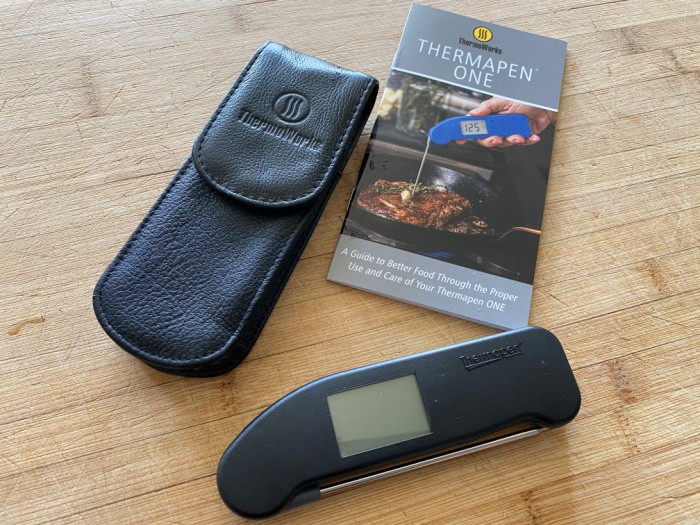
What temperature should the turkey register when it’s done?
The USDA recommends at least 325°F (162°C) in the thickest part of the turkey.
How long will the cooked turkey stay safe in the refrigerator after cooking?
After you cook the turkey and refrigerate the sliced turkey meat, you have a short window before there is a safety risk. The turkey is only suitable for 3-4 days in the refrigerator.
Can dogs eat turkey?
I checked the American Kennel Club website to see what they had to say. Basically, dogs can eat almost any meat that is properly cooked for human consumption. Just make sure the meat you give them is free of any bone or gristle that might get caught in their throat.
The AKC indicated that most veterinarian visits this time of year are due to the “trimmings” given to dogs. That’s mainly due to the spices, butter, and other ingredients that are often applied to the skin or added to the stuffing. Be exceptionally careful of onions and garlic, which can upset their stomach
It is usually okay to serve turkey, potatoes, sweet potatoes, and veggies like peas. Steer clear of pumpkin pie since it has Xylitol, which is toxic to most animals. Master Class: Can Dogs Eat Pumpkin Pie
How do I make turkey gravy?
I’d like to suggest the following simple recipe for turkey gravy. Anyone should be able to put this one together:
Ingredients:
1/4 cup of the turkey drippings, which includes the fat and any juices generated during the cooking process
1/4 cup of all-purpose flour
2 cups of liquid, which can be from the cooked turkey, some turkey broth, and water
1/2 teaspoon of salt (you can adjust based on personal preference)
1/2 teaspoon of pepper
Cooking Steps:
Take the drippings from your roasting pan and put them in a bowl, while leaving any brown particles in the pan. Take 1/4 cup of the drippings and put them back in the pan. Stir in your flour.
Cook this mixture over medium heat, stirring continually until the mixture is smooth and has bubbles. Stir in the liquid ingredients while heating to a boil, again stirring continually. You’ll stir this boiling mixture for at least a minute. Add and stir in the salt and pepper. Serve while hot.

How do you season a turkey?
Some turkeys can come seasoned, but a safe bet is to brine the turkey as discussed above. I just put mine in the pans without seasoning right from the package. Please tell me what you do with your raw turkey. I like simple solutions, so sometimes I use All-Seasoning Salt.
One traditional way to treat a turkey is by basting it. You bast the turkey by taking the liquid you see at the bottom of your pan and spreading it out over the top of the turkey, paying particular attention to the breasts of the bird. You can do it as often as you’d like, but every half hour to an hour will probably be sufficient.
Basting helps keep the meat moist since it tends to slow down the cooking process. It also causes the liquid from the pan to caramelize on top of the turkey during the cooking process. You can use a basting brush, a large spoon, or a ladle.
Is it safe to stuff a turkey with stuffing/dressing?
The USDA suggests you cook your stuffing in a separate pan. The stuffing CAN affect the temperature and cooking time as illustrated above. Better to be safe than sorry. If you want to cook the turkey and stuffing/dressing together, be sure to follow the times shown based on the weight of the turkey being cooked.
How many pounds of turkey per person should I plan on buying?
Generally speaking, you should plan on 1-1/2 pounds of turkey per person. So add up the turkey-eating guests and plan on this amount per person. It’s almost easier to plan on 1 pound per person (there’s a lot of bone in turkeys).
So if you have 20 quests, plan a 20-25 pound turkey. Of course, we want leftovers for sandwiches, right? Maybe a 25 to 30-pound turkey would be perfect. You can always freeze the leftover turkey meat. Since children tend to eat less, you may need to make some adjustments if there are many younger guests.
Can I freeze the leftover turkey?
You can keep the cooked turkey in your fridge for a few days, but the safest bet is to freeze any leftovers. Mark and I love to make turkey sandwiches for days after the holidays. When he trims the turkey he tries to separate the dark meat from the white meat since he prefers dark and I love white meat.
When it comes to the cleanup phase, we put the meats in smaller freezer bags and then pull them out and thaw them in the microwave so the meat is ready for a sandwich or larger meal with the leftover gravy, cranberry sauce, and other goodies. Gotta love holiday meals and all the leftovers. If properly wrapped, the cooked turkey will be good in the freezer for 3 to 4 months.
How do you carve a turkey?
Allow your turkey to cool
The most important thing to do before carving a turkey is to allow it to cool at room temperature for about 15-30 minutes. This is called letting the turkey “rest.” This allows the juices to settle a bit, giving the meat a chance to absorb the juices so that the moisture is retained in the bird rather than being released onto the plate during carving. Allowing the turkey to cool down before carving will also make it easier to handle while carving.
Items you will need for carving
You will need a good quality sharp knife. It doesn’t need to be a special carving or boning knife, but it does need to be sharp. You’ll want a roomy cutting board so you can shift or move the bird around some as you cut it. Depending on how you separate your cut pieces, you’ll need one large plate or separate plates for the different cuts of meat.
Cut the twine on the turkey
Place the cooked turkey on the cutting board with the cavity facing towards you. You will need to cut any butcher’s twine that is holding the legs together. That gives you access to all the turkey parts you want to cut away.
Cut off the thigh and leg of the turkey
There is skin near the top of the thigh that needs to be cut so you can cut the leg from the body of the bird. Once the skin is cut you can see the joint that needs to be cut so you can pull the leg from the body. It may take a little tugging to break the joint and pull it while cutting along the body. You’ll repeat this step with the other leg.
Then slice the wings from the bird
You can cut off the wings by pulling them back from the body until you hear a popping sound. Slice through the skin and joints much as you did with the legs.
Now remove the breasts
On the top of the turkey, you’ll see the breastbone. Take your knife and cut along the side of the breastbone. The bone will curve toward the back of the turkey as you cut, making some long strokes to separate the thick white meat from the breastbone. You’ll do the same thing on the other side of the turkey.
Cut up the white breast meat
The breasts provide the most meat from the turkey. Although the darker meat can at times be moister, it seems most people prefer the taste and texture of white meat. You’ll want to cut the breast meat into slices that people will want to put on their plates from your serving platter. This also provides slices that can be placed in freezer bags for future use.
Now slice the dark meat
You’ll want to separate the thigh from the drumstick. This is another task that requires you to cut through the joint. You can cut the meat from the drumstick, but sometimes you’ll have a guest who likes to eat the dark meat right from the drumstick itself, much like you would picture the Vikings did in the olden times. Now the thigh is there for you to slice once you’ve removed the thigh bone.
What can I serve with roasted turkey?
- Mashed Potatoes
- Gravy
- Caramelized Carrots
- Coleslaw
- Baked Sweet Potatoes
- Mac and Cheese
- Fresh Cranberry Salad
- Homemade Rolls
- Stuffing
Looking for a turkey recipe to use to make with your leftover turkey? Check these out!
- Our Favorite Thanksgiving Leftover Turkey Ideas
- Easy-To-Make Turkey Soup
- 20 Ways To Enjoy Turkey Leftovers
- Easy Turkey Pot Pie
- How To Make Turkey Cranberry Roll-Ups
My Thanksgiving Tip
I have done this for years, laminate your recipes and grab some cookie sheets. Place all of the measured ingredients on each cookie sheet so those who are helping with the meal can make the recipe with ease.

Final Word
We all enjoy the holidays, this special time of year. It means getting family and friends together for great food and conversation. Although it can be a lot of work preparing meals for each holiday, it is surely worth it to create lifetime memories and good food to match.
I hope this post about how to cook a turkey proves helpful as you begin your holiday meal plans for Christmas, Thanksgiving, and possibly New Year’s, too. Refer to it often, print out the recipe information for a quick reference, and relish the delicious meals for weeks to come. May God bless this world. Linda
Copyright Images: Whole Roasted Turkey AdobeStock_288597690 by Fahrwasser, Roasted Turkey AdobeStock_173682238 by Africa Studio
The post How To Cook A Turkey appeared first on Food Storage Moms.
from Food Storage Moms
No comments:
Post a Comment